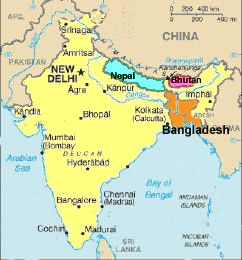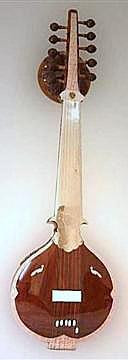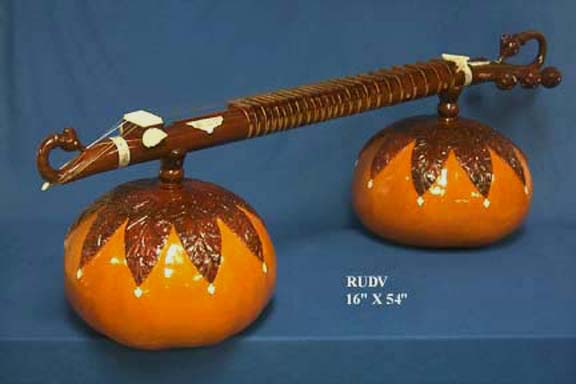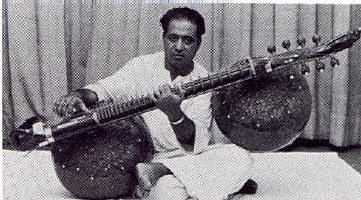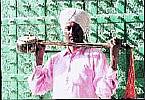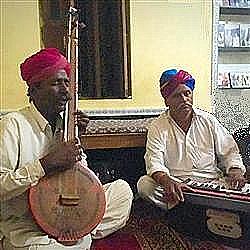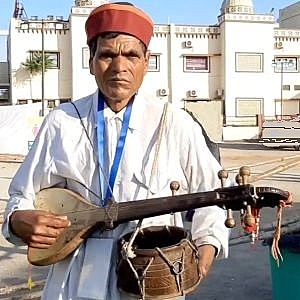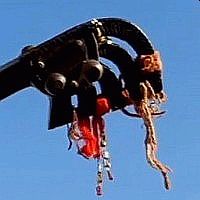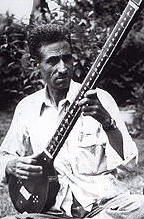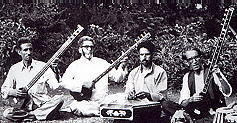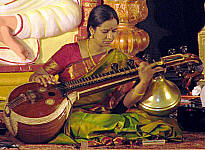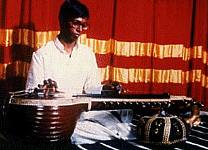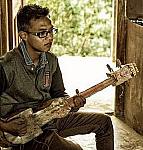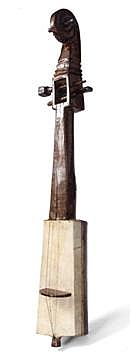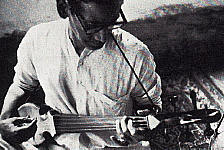| India | ATLAS of Plucked Instruments |
| •
HOME • about • collection • books • index • links • lutes • guitars early • guitars modern • mandolins • cittern • banjos • steelguitars • miscellaneous • Europe West • Europe East • Europe South • Africa • Middle East • Central Asia • India • Far East • S.E. Asia • America N • America C • America S
|
India Here we find the interesting instruments of India
: North India,
Kashmir, South
India, all India,
Northeast India.
Also included are a few typical instruments from
Bangladesh. Not all plucked instruments from the Indian Sub-continent are wellknown in the West : just the sitar and the sarod can be heard quite often - the others only occasionally enter our music stages. One of the main remarkable features of Indian instruments is the addition of a number of thin extra (resonance or sympathetic) strings. They are not plucked themselves, but start to vibrate when the main strings are plucked. Usually they are tuned to all the different notes that are used in a particular piece (raga). This gives quite an enhancement of the sound - like a vague echo. Drone strings are also used, like they are on many long-neck lutes of Central Asia.
|
| top | North India | ||||||||||
|
sitar
The sitar is India's most famous instrument (mainly thanks to Ravi Shankar) and used in Hindustani music. It is made in different sizes. The body of the sitar is made from a large gourd, with a front of hard wood. The neck is also made of hardwood and hollowed out. It is covered with a fingerboard, which is slightly concave. The neck extents into the tuninghead. The frets are made of half round metal hoops, which are tied to the neck with nylon string, and can be moved. The second gourd on the top is mainly for decoration and is often absent. The edges of the neck, body and tuning head are inlayed with bone, often with red and white etching. The back of the body has some woodcarving. All strings are of metal. There are 7 main strings,
3 of which are fingered; the others serve as drones. The two lowest
ones are the high chikari strings, which are played separately for rhythmic
effects. Usually there are two big round friction tuning pegs on the
front, and 3 on the left side of the tuning head, while the two pegs
for the chikari strings are of similar size, but on the left side of
the neck and run over separate stick bridges half way the neck. Playing the sitar is with a wire finger-plectrum (mizrab), so you can pick up and down. The strings are all on the left side of the neck, so you have space to pull the strings (mainly only the first one) upwards to 4 notes. Music was not written down, but learned by the pupil from the masterplayer. Classical Indian music is very old and a whole repertoire of raga's exist.
|
||||||||||
| top | |||||||||||
|
sarod
The sarod is one of the leading Hindustani instrument of today. It is a descendant from the wooden rabab (see seni rabab here under). A well known sarod player is Ali Akhbar Khan. The body and neck is made from one piece of hardwood, hollowed out (it is more rounded and less deep than the afghan rabab). The bottom half is covered with (glued) skin and the top half (with the neck) is covered with a (screwed on) shiny metal plate. Between neck and body are hollow ridges on both sides. The pegbox is a solid piece of wood, joined to the neck and curves slightly to the back. On the back of the neck is a metal gourd-shaped resonator. All wood is painted dark brown. There are 23 metal strings, divided in 4 main strings, running from 4 big round friction tuning pegs on the left of the pegbox, over the main nut to the right side of the single main bridge on the skin. Then 4 thin strings running from the 4 pegs on the left side of the pegbox, over a flat separate nut, to the left side of the bridge, where they go through separate individual holes. The shikari strings (used for rhythmic effect) run from 2 pegs on the top of the neck, via a special nut half way the neck to the top of the bridge, on the left side. On the left side of the body are 13 smaller pegs (in 2 rows) from where the resonance strings run via small holes in the fretboard, to the lowest level of holes at the left side of the bridge. All strings are fixed to 8 steel pins at the edge of the body. Playing the sarod is done with a special thick plectrum made of coconut. The music is similar to the music played on the sitar, with ragas which are handed down from master player to the pupil. The left hand fingers the string with the edge of the nail (of the first two fingers). Often players glue artificial nails to their own nails.
|
||||||||||
| top | |||||||||||
|
sursringar
The sursringar (or sursingar) is the older version of the sarod (see above). It is a descendant of the wooden rabab (see seni rabab here under). Being larger than the sarod, the sursringar can be regarded as a bass sarod. It is rarely used anymore. The body of the sursringar resembles much the
body of the sitar. The front is (like the sitar) made
of wood, so not with skin, like the sarod. Playing the sursringar is done with a special thick plectrum. The music is similar to the music played on the sitar, with ragas which are handed down from master player to the pupil. The left hand fingers the string with the edge of the nail (of the first two fingers). Often players glue artificial nails to their own nails. |
||||||||||
| top | |||||||||||
|
seni
rabab The Afghan rabab (see
: Central Asia)
used to have an Indian relative, called the seni rabab. It
differed from the Afghan rabab by having only 6 main (thick
gut) strings and no frets. The seni rabab fell in disuse since
the first half of the 20th century, and was still only played by the
Sikhs to accompany their songs.
Playing the seni rabab is done with a thick
plectrum. |
| top | ||||||||||||||
|
surbahar
The surbahar is the bass sitar. It was developed in the 18th century to play the classical dhrupad music style on a sitar-like instrument. Later the sitar itself was modernized halfway the 20th century to its modern shape. The main difference between a surbahar and a sitar is (besides being a larger instrument, with thicker strings) the peghead, which has a carving of a snake or a bird. Also the back of the body may be flatter. |
|||||||||||||
| top | ||||||||||||||
|
rudra
veena The rudra veena [also bin, been, vina] is an old North Indian instrument used in Hindustani music, and similar to the vichitra veena . It is rarely used anymore. One modern player is Bahauddin Dagar (large veena). The rudra veena is basically a rounded teak wood body/neck/ fingerboard, fixed on two large gourds and on both ends a woodcarving of a peacock. Twenty-two straight wooden frets are fixed to the fingerboard with wax, or tied around the neck. All strings run from 8 friction pegs on the tuning head - 4 on each side. There are 8 strings - 4 main strings, 3 drone strings on the right (the side of the player) and one drone on the left. It has no resonance strings, and there are 3 separate bridges. The veena is played sitting down with one gourd over the shoulder, or resting on the left knee. The right hand picks (often with 2 wire plectrums worn on index and middle finger), while the drone strings are played with the nail of the little finger. The left hand fingering is quite difficult as you have to grip the strings from underneath the horizontal neck. The hand also touches (blocks) the drone string on the side.
|
|||||||||||||
| top | ||||||||||||||
|
vichitra
veena The vichitra veena is a North Indian instrument used in Hindustani music and looks quite similar to the rudra veena. The difference is that the vichitra veena has no frets - it is played with a "steel", like the gottu vadyam in Carnactic music. It is rarely played anymore. The body is made from teakwood, more wider than the round shape of the rudra veena, and with a small body. Also both ends have a wood carving (often of a bird). Besides the 7 main strings, there are about 12 resonance strings, with the pegs on the side of the neck (facing the player). It is played sitting down with the instrument horizontally in front of the player. The right hand picks with a wire plectrum, while the left hand "frets" with some piece of rounded glass. This way of playing (like lapsteel) makes it difficult to play fast passages accurately.
|
|||||||||||||
| top | ||||||||||||||
|
tumbi
This simple and small folk instrument tumbi is used In North India, in the Punjab. It is sometimes called ektara (''one string"); a similar instrument with 2 strings is called dotara. The tumbi (also spelled toombi) is
made from a small piece of round hard wood, hollowed out, and covered
with a thin animal skin; usually glued around the edge, but sometimes
also nails are used. The tumbi is played by holding it almost horizontally
and strumming the string gently with the forefinger of the right hand.
With the left hand a few notes can be played.
|
|||||||||||||
| top | ||||||||||||||
|
tandura
The wellknown drone instrument tampura - which
is used in the classical Indian music (see under) - has a relative in
Rajasthan, which is called tandura (or chautara). The body of the tandura is carved from a piece
of tunwood. It is round and hollowed out like a deep big bucket. The
front is covered with a thin piece of similar wood, with a small strip
around the top of the side, which goes a bit up the sides of the neck
to cover the join with the neck.
|
|||||||||||||
| top | ||||||||||||||
|
jantar
The jantar is basically a one meter long stick,
made of bamboo. At one end is a small wooden extension, which serves
both as stringholder and as bridge. The jantar usually has 3 or 4 metal strings
: two run over the frets, but only one is played, the other is only
a drone. These two strings rest on the first fret that serves as nut.
|
|||||||||||||
|
rubana
The body and neck of the rubana is carved from a solid block of wood. The back is rounded, and the shape of the front depends on the maker : oval, roundish or teardrop. The front is covered with a skin. Near the base of the neck are small extensions on both sides. There are no soundholes.
The six nylon strings are running over a large loose
wooden bridge on the skin to a fixture at the end of the body. The strings
are probably tuned in a open chord. |
|||||||||||||
| top | Kashmir | |||||||||||||
|
kashmiri
setar In Kashmir (the mountainous area of North West India) exists a long-neck lute, which is a kind of hybrid between an Iranian setar and Indian sitar. There are two sizes : the long one is called bod, with 9 strings, and the small one : lokut with 7 strings. Only the big one is still used and even that one not often. The body of the kashmiri setar is made of 12 ribs glued together, with a wooden front. In the front are several small soundholes. The neck is hollow (like the sitar) forming part of the resonance chamber of the body. There are 17 tied-on gut frets. The bridge is wide and flat, and slightly rounded (like on the Indian sitar and sarod). The 7 main steel strings run to round pegs on the tuning head (3 on the front, 4 on the left side). Two shorter strings go to pegs at the left side of the neck, and pass over small separate bridges. Only the first two (double) strings are fingered (like on the tamburs). Playing is with a wire plectrum on the right hand index finger. The melody is played on the first two strings, the other strings are only strummed for drones. The left hand only fingers with index and middle finger. In each ensemble there are two or more setars. Notice that the now rare "saz-e-kashmiri" is a kind of fiddle.
|
|||||||||||||
| top | South India | |||||||||||||
|
(saraswati)
veena The veena (or been or bin or tanjore veena or tanjauri veena or saraswati veena) is an old south Indian instrument for playing Carnatic music; it is still very popular - so nowadays even fiberglass bodies are made. The body of the veena is not made of a gourd
(like most of the North Indian instruments), but carved from a solid
piece of Jack wood, in quite a round body shape. The better quality
ones have the entire instrument (body plus neck) carved from one piece.
The neck is hollow, with on top a U-shaped box. On the edges of that
box are about 24 round brass frets glued with black wax. The body has
usually two round soundholes on the front. The top resonator has no
musical function, and can be made from brass, plastic or papermaché
and is often decorated.
For more information on how they are made see swansong. |
|||||||||||||
| top | ||||||||||||||
|
gottu
vadyam The gottu vadyam (or gottuvadyam or gottuvadhyam) is a popular instrument in South India, for playing Carnatic music. It is also called chitravina. It is in fact a fretless veena. In general the instrument looks very much like the veena, except that there are no frets and that it has resonance strings (as the only instrument in South India), which are fixed to tuning pegs at the side of the hollow neck. The gottu vadyam is played like the vichitra veena : laying horizontal in front of the player, with in the left hand a piece of hard wood or round glass object as "steel". It is difficult to play accurate in fast passages.
|
| top | |||||||||
|
nanthuni
The two metal strings are tuned with |
| top | all India | ||||||||||||||
|
tampura
The Indian tampura is in fact not a plucked stringed instrument in the sense of this website, as the (3, 4 or 5 ) strings are only played open, as drones. However it would be a pity not to include it here. There are several types - the large male and the smaller
female tampura, while there is a third smaller one - the travelling
tampura. (see the example) The tampura is made quite similar to the sitar : the body from a large gourd, with a wooden top. The neck is made of hardwood, and hollow. There are 4 metal strings, fixed to 4 tuning pegs : two on the front and one on each side of the pegbox. The bridge is wide and rounded to give a buzzing sound to the strings. There is quite a lot of woodcarving on the body, and lots of inlay with red and white drawings all over the instrument. The body of the small travelling tampura is made from wood, and is rather flat on the back. Playing is done sitting down on the ground, and holding the tampura straight up with the left hand. The right hand plucks the strings one by one in a slow tempo, to give a continues drone for the main (solo) instrument.
|
||||||||||||||
| top | |||||||||||||||
|
mohan veena / indian slide guitar Some Indian players have picked up the western jazz guitar and transformed it into a real Indian-style instrument, playing it like a lapsteel. One of the main players (and inventors) is Mr. Vishwa Mohan Bhatth, whose name is often used for this type of guitar - the mohan veena. Another renewer/player is Debashish Bhattacharya. Both play classical Indian music and manage to play the raga's extremely fast, but very accurate. Another name is Jaywant Guitar. The type of guitar that is used for the mohan veena is usually a modern large jazz guitar with f-holes. There are 8 strings on the tuning head, and at the side (on a plank fixed to the side of the neck) are about 12 extra tuning machines for the resonance strings. Usually only 3 main strings are played with the steel, the rest are drones.
|
| top | ||||||||||
|
bulbul
tarang
This nice small music box is like a combination of a
typewriter, a mandolin and a dulcimer. For more information about the bulbul tarang,
see chandrakantha.
|
| top |
| top | Northeast India | |||||||||||
|
||||||||||||
| top | ||||||||||||
|
tati
/ libuh The Chokri people
of the Chakhesang tribe in Nagaland (one of the states in Northeast
India) use a folk instrument which is called tati, or libuh
or heka libuh.
The tati is mainly a straight round pole of
about 120 cm long. It is made from a special kind of bamboo. The pole
has no frets. |
|||||||||||
| top | ||||||||||||
|
duitara
The Khasi tribe (living in and near Shillong in the state
of Meghalaya, in Northeast India) uses a folk instrument called duitara.
The Garo people use a similar instrument, called dotdrong. The body, neck and peghead of a duitara are carved from one piece of wood. The hollowed out body (a bit resembling an upside down toadstool) is covered with a thick skin, glued and nailed to the sides. Some makers give the body sharp corners, others make it more rounded.
The 4 yellow rope strings run over a loose wooden bridge
to a (metal) stringholder at the end of the body. On some instruments
the 4 strings are separate, on others the two middle strings are as
one pair. Tuning could be : A dd a. The duitara is played with a plectrum, to accompany singing in a style that resembles the Tibetan dramyen. |
|||||||||||
| top | ||||||||||||
|
chongpreng
In Tripura (a state in Northeast India) they use a folk instrument called chongpreng. The body, neck and peghead of a chongpreng
are carved from one piece of wood. The body is in the shape of a rectangle.
It is hollowed out and the front is covered with a thin skin, which
is glued to the sides. Older models had instead of the skin a thin wooden
front nailed to it. The chongpreng is played with a plectrum, to accompany singing. |
|||||||||||
| top | ||||||||||||
|
tokari
In Assam (a state in Northeast India) they use an instrument which is called tokari or tukari. It is quite similar to the dotara which is used mainly in Bangladesh (see under). The body, neck and peghead of a tokari is (like
the dotara) carved from one piece of hard wood. The hollowed
out body is covered with a skin (often of a small animal like a lizard
or mongoose). The skin is glued and nailed along the edges, and often
has a few small holes in a pattern. There are four or five friction pegs on the open pegbox
: 2 on the right and 2 (or 3) on the left side. The tokari is played with a plectrum (fixed on a rope), often to accompany singing.
|
|||||||||||
| top | Bangladesh | |||||||||||
|
dotara
(1)
In Bangladesh - but also in nearby Northeast India -
several different looking instruments are used but all with the name
dotara (or dutara). Other names for the same instruments
are phentor banam (or spelled fentor
or fantor). There are three main different models of dotara : mainly in the north they use a rounded shape body, while in the south they use a body that resembles the Indian sarod (see next item). The third type has a small rounded soundbox (see under). Here the first type, which is in Bangladesh mainly used
by the Baul people. The body, neck and peghead of a rounded body dotara are carved from one piece of hard wood. The hollowed out body is covered with a thick skin. The partly hollowed neck is covered with a fingerboard of very flat and slippery material - like formica, metal or plastic. There are no frets. The pegbox often ends in a woodcarving, usually the figure of a bird (a peacock). The entire instrument (except the front) is varnished. The open pegbox has 4 or 5 large round friction pegs
: 2 on the right and 2 (or 3) on the left side. The 4 or 5 (metal or
rope) strings run over a loose wooden bridge to a metal stringholder
at the end of the body. The dotara is played with a plectrum, often to accompany singing.
|
|||||||||||
| top | ||||||||||||
|
dotara
(2)
The second type of dotara resembles the Indian sarod. It is mainly used in the south. The body, neck and peghead of this dotara are
carved from one piece of hard wood. The body looks a bit like an Indian
sarod, with grooves on both sides. The hollowed out body (resembling
a bit the shape of an upside down toadstool) is covered with a thick
skin. The pegbox often ends in a woodcarving, usually the figure of a bird - a peacock. The entire instrument (except the fingerboard and the skin) is usually varnished - in wood colour or black. The open pegbox has 4 or 5 large round friction pegs
: 2 on the right and 2 (or 3) on the left side. The 4 or 5 (metal or
rope) strings run over a loose wooden bridge to a metal stringholder
at the end of the body. Some dotaras may have a few resonance
strings at the left side of the neck. The dotara is played with a thick wooden plectrum (attached with a string), often to accompany singing.
|
|||||||||||
| top | ||||||||||||
|
dotara
(3)
This is the third type of dotara used in Bangladesh and Northeast India (mainly by the Santal people). This one is quite narrow with a small round soundbox.
The body, neck and peghead of this dotara are
carved from one piece of hard wood. The hollowed out round body plus
the first bit of the neck is covered with a thick skin. The rest of
the neck is covered with a fingerboard of very flat and slippery material
- like shiny metal, or sometimes formica or plastic. There are no frets.
The open pegbox has 4 or 5 large round friction pegs
: 2 on the right and 2 (or 3) on the left side. The 4 or 5 (metal or
rope) strings run over a loose small wooden bridge to a metal stringholder
at the end of the body. The dotara is played with a thick wooden plectrum (attached with a string), often by young girls, to accompany their own singing. |
|||||||||||
| top | ||||||||||||
|
gopichand
This is in fact a rhythm instrument, but I have decided to include it here anyway, as the tone can be slightly altered. It is sometiomes also called ektara ("one string"), although that name is also used for the tumbi of the Punjab (see above). The gopichand is made from a coconut shell,
with attached to it a "split" piece of wood, with two "arms".
The top and bottom of the coconut shell are cut off, the top side is
left open and the bottom side is covered with a thin skin. A thin metal
string is fastened through the centre of the skin, which can be tuned
with a friction peg on the end of the (split) piece of wood.
|
|||||||||||
|
